Each mushroom is unique in its own way. It has its own specific taste and smell, as it absorbs the aromas of the environment in which it grows. According to many mushroom pickers, mushrooms growing under pine tree forests have a particularly delicate taste. But it is worth remembering that they can be both edible and poisonous, and every fan of quiet hunting, especially a beginner, should be able to distinguish mushrooms.
Let’s delve into the world of mushrooms that grow under the pine trees, offering insights for both novice and experienced foragers.
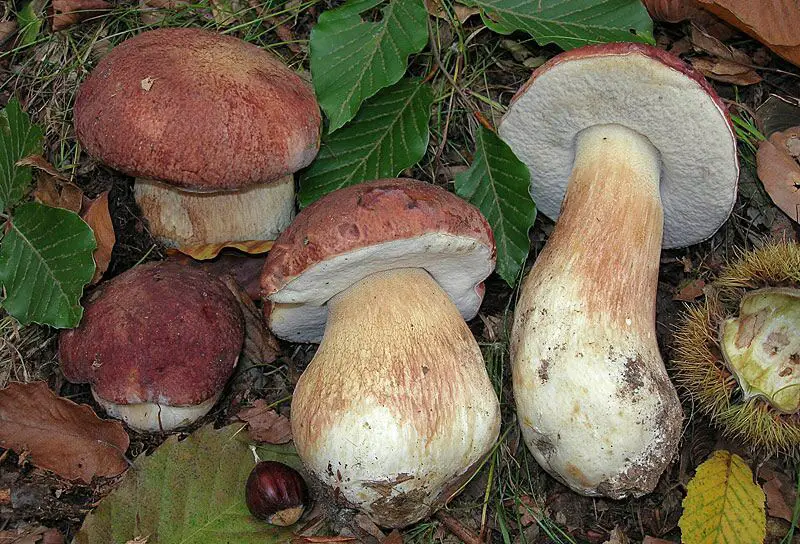
Mushrooms that grow under pine trees forest
Table of Contents
Natural conditions of pine forest for mushroom
Pine forests serve as a vital habitat for essential and beneficial substances like phytoncides, making them a “little homeland.” The air within these forests is recognized for its healing properties, particularly beneficial for individuals with respiratory ailments. Moreover, mushrooms near pine trees or thrive in these environments, enhancing their nutritional value.
Within these forests, mushrooms proliferate extensively, forming mycosis alongside diverse vegetation, including shrubs, trees, stumps, grasses, and ferns. The pine trees allow ample sunlight and oxygen to reach the soil, which is covered with mosses and shrubs such as lingonberry, juniper, and blueberry. These elements create an optimal nutrient medium (substrate) for mushrooms, explaining their abundance in coniferous forests.
The presence of mushrooms in these locations is not merely coincidental; they play specific roles. Through their life processes, fallen pine needles break down, contributing to the natural fertilization of the soil. The same occurs with fallen trees and dry branches. Simultaneously, pine tree mushrooms with essential trace elements and carbohydrates produced by their hyphae, receiving nutrients in return from the tree roots.
Want to know about Mushrooms Growing on Tree Stump with pictures
All mushrooms under pine trees are not edible but below we will first discuss what mushrooms grow under pine trees? edible mushrooms and poisonous mushrooms.
What edible Mushrooms that grow under pine trees?
edible mushrooms that grow under pine trees, you need to be able to look for. And for this it is important to know how they look. Some of them have dangerous twins, which the eye of an inexperienced mushroom picker may not immediately distinguish.
Boletus mushroom that grow under the pine tree
One of the most favorite fruits for many mushroom pickers. It is also the most valuable member of the Boletov family. It has a cap with a circumference of 8-25 cm and a thick stem from 7 to 16 cm. The flesh is white, has a pleasant aroma, and does not change color when broken or cut.
The shade of the fruit is light cream, and a fine mesh can be traced on its surface. It grows in those conifers where the soil is sandy. It is harvested from June to October.
- Distinct Features: Recognizable by its cap, ranging from 8 to 25 cm, and stout stem measuring 7 to 16 cm.
- Aroma and Appearance: Boasts white flesh with a delightful aroma, maintaining its scent even when sliced. Its light cream hue adorned with a delicate mesh pattern sets it apart.
- Habitat and Harvest: Thrives in sandy soil amidst coniferous regions, ripe for picking from June through October.
Saffron milk cap
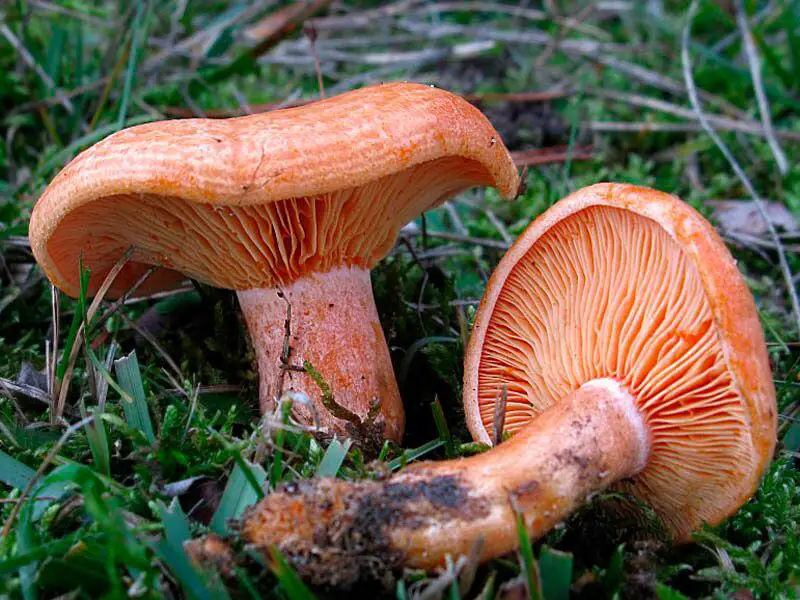
Saffron milk cap belongs to the genus Multifurca. They have a bright red tint with reddish notes, for which they got their name. The cap has concentric rings. Its edges are bent down, and the circumference varies between 5-12 cm.
The stem of the fruit has the same color as the cap section. It is narrowed downwards, noticeably widens upwards, and has a length of 4-10 cm.
The pulp is quite dense. When damaged, it begins to noticeably green. Along with this, milky juice of a light orange hue is intensively released from the damaged area. It is recommended to collect mushrooms in July-September.
- Vibrant Presence: With its vivid red hue tinged with reddish undertones, the saffron milk cap captivates foragers.
- Distinctive Characteristics: The cap, ranging from 5 to 12 cm, features concentric rings, while the stem mirrors its coloration, narrowing towards the base.
- Identification Signs: Upon injury, the dense flesh reveals a noticeable green tint, accompanied by the release of milky juice with a light orange hue.
- Season of Harvest: Best harvested from July to September.
Tricholoma equestre: yellow mushroom under pine tree
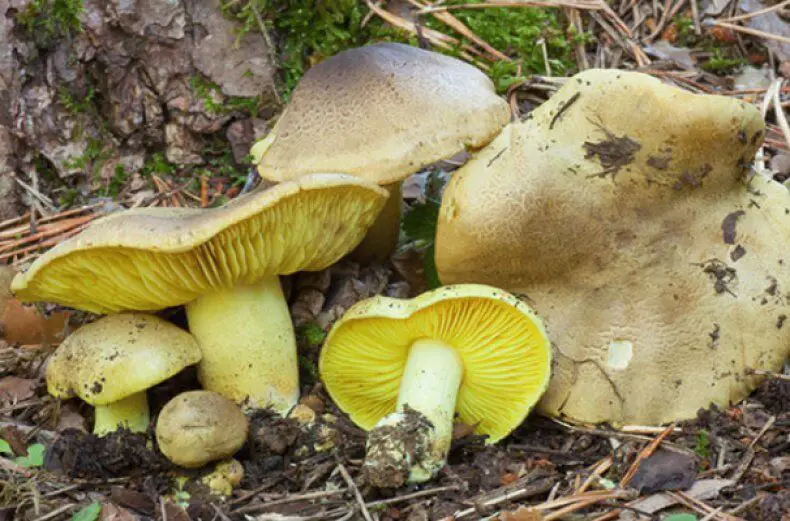
Tricholoma equestre a small mushroom with a characteristic greenish color. The hat is prostrate, about 15 cm in circumference. In the center there are small numerous scales.
The leg grows low – no more than 5 cm. The flesh of young fungi is whitish but eventually becomes slightly yellowish. The cut color does not change. The growing period lasts from September to November.
- Appearance: Small mushroom with a greenish hue, featuring a prostrate cap with small scales.
- Leg: Grows low, up to 5 cm, with whitish flesh turning slightly yellowish over time.
- Season: September to November.
Tricholomopsis rutilans
Tricholomopsis rutilans settle on the stumps of pines or other conifers. They grow mainly in groups, it is almost impossible to meet them one by one.
The hat is small, matte, scaly, velvety to the touch. Its color is red-orange. The leg is the same in shade, but curved in shape, and current in terms of parameters. Its height does not exceed 5-7 cm.
- Habitat: Often found on pine stumps in groups.
- Features: Small, matte, red-orange cap with a curved leg.
- Size: Cap ranges from 2 to 12 cm, leg height doesn’t exceed 5-7 cm.
Chanterelles
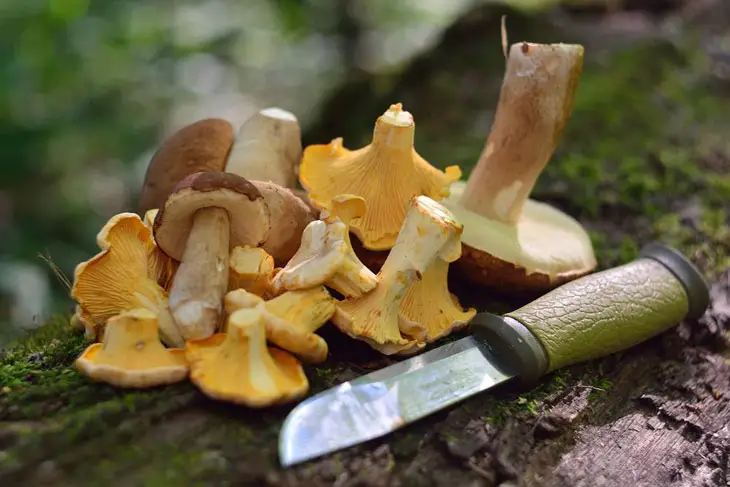
These are unique mushrooms that can be found in pine forests and plantings. They are bright orange or yellow-orange in color.
The cap is wavy, inside there is a visible recess, and on the sides there are twists, waviness. Its size ranges from 2 to 12 cm. The pulp is very fleshy, and fibrousness is noted in the leg. The top becomes noticeably wider.
- Distinctive Traits: Bright orange or yellow-orange cap with wavy edges and visible recess.
- Value: Known for palatability and resistance to parasites.
- Caution: Ensure proper identification to avoid toxic look-alikes.
Chanterelle is valued for its palatability and high resistance to parasites. But she has a double that cannot be eaten. Therefore, before going to the forest, a novice mushroom picker needs to learn to distinguish between true and false foxes.
Suillellus luridus
Suillellus luridus mushrooms are quite common in conifers. These fruits like to grow in areas abundantly overgrown with moss. The cap of the mushroom is usually painted in a greenish or greenish-grayish tint. Sometimes it is brown mushrooms under pine trees. When touched, it feels velvety. The shape is slightly convex.
The stem of the fungus grows up to 3-11 cm, cylindrical, expanding upwards. Sometimes a brownish mesh can be traced on it.
- Habitat: Common in coniferous areas with moss.
- Cap: Greenish or greenish-grayish, sometimes brown, with a velvety texture.
- Stem: Cylindrical, up to 3-11 cm, may have a brownish mesh.
Important! Despite the fact that the flywheel is edible, sometimes its surface is covered with mold. Such a fruit should not be consumed – it is dangerous to health!
Want to know where to find turkey tail mushroom.
Parasol mushroom
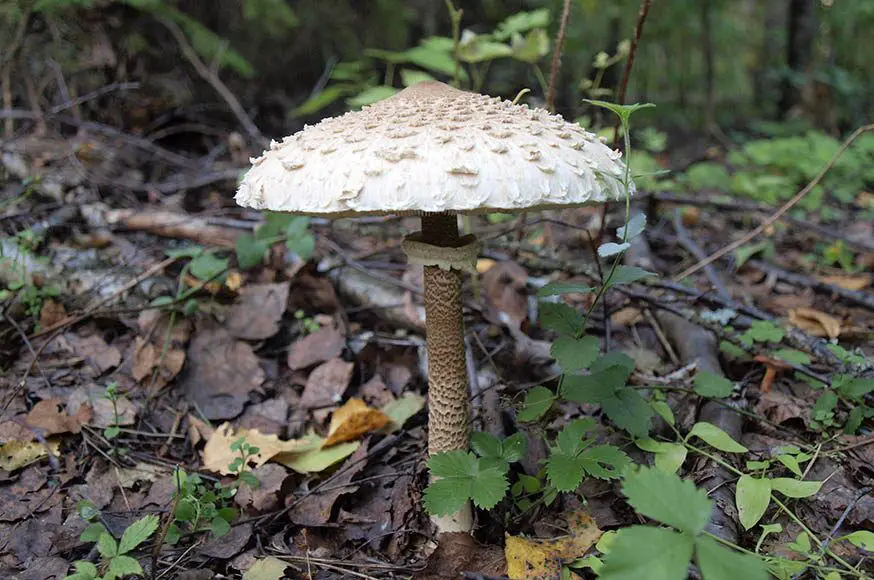
The Parasol mushroom is covered with a fibrous layer. It is gray or beige, on its surface there are dark brown scales. In young fruits, it is spherical, in more mature ones it becomes prostrate, resembling an umbrella.
The leg can be quite long – from 10 to 35 cm. It has scaly rings on its surface, or a simple ring with particles of a bedspread.
The pulp is loose to the touch, has a white color and a pleasant mushroom aroma. To taste, the umbrella mushroom resembles champignons or walnuts.
- Distinctive Color: Starts with a lilac hue, fading over time to pale lilac.
- Features: Small, flat cap, elastic and fleshy flesh.
- Leg: Low, 4 to 8 cm, with fibrous covering and purple flesh.
wood blewit
The unusual appearance of this fruit attracts the attention of mushroom pickers. The row has a distinct lilac color at a young age, but fades a little over time, becoming pale lilac.
The hat is small only 6-15 cm. The shape is mostly flat but maybe slightly convex. The cap part is quite dense, fleshy. Its edges are uneven.
The leg is low from 4 to 8 cm, and in thickness, it can reach 1.5 – 2.5 cm. It is even, covered with a fibrous layer, becomes thicker towards the base. The flesh is quite elastic and fleshy. It has a purple color and has a fruity aroma.
- Distinctive Appearance: Starts with a lilac hue, fading to pale lilac over time.
- Cap: Small, 6-15 cm, mostly flat or slightly convex, dense, and fleshy.
- Leg: Low, 4-8 cm, with purple flesh and a fruity aroma.
Mushrooms that grow on and under birch trees and how to find them.
Inedible or poisonous Mushrooms that grow under pine trees
Inedible fruits should not be collected even as an option for harvesting. Not all of them are poisonous, but their specific flavor notes make them unappealing to gourmets.
Lepista: white mushrooms under pine trees
The color of the mushroom is completely white. The hat can grow up to 10 cm in diameter. At first, the fruit has a convex, then prostrate shape, while a tubercle may form on the cap surface.
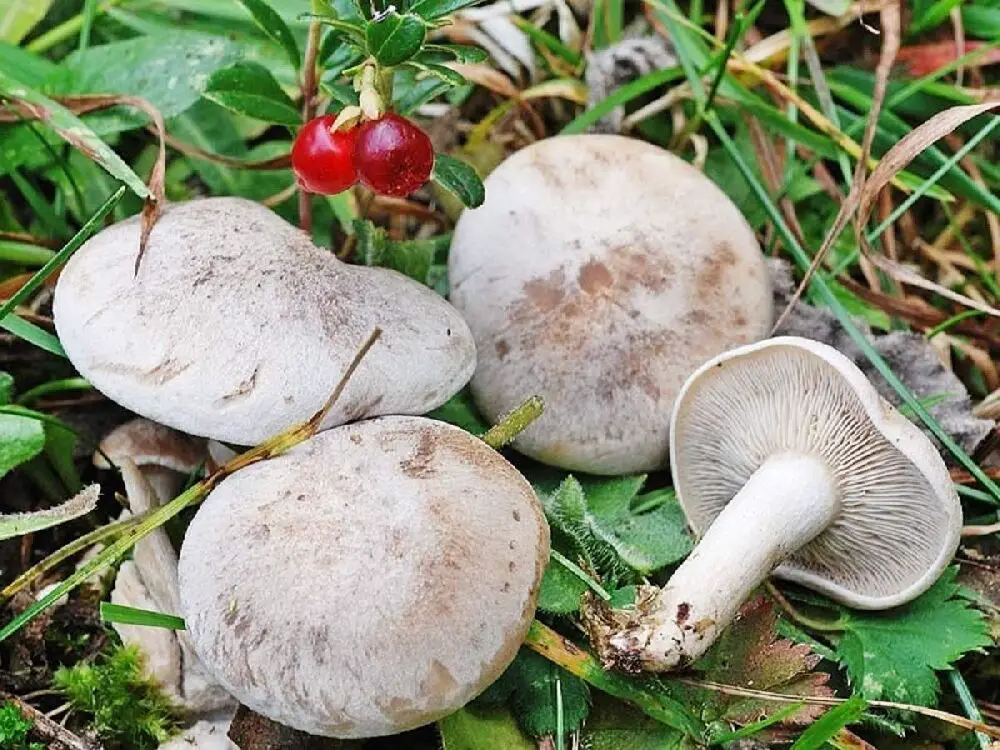
The leg of the talker is low since it grows mainly up to 3 cm. Its diameter is from 0.5 to 1.5 cm. The structure is dense. The mushroom grows not only in pine forests but also in mixed types of forests. The period of active fruiting falls from July-October.
- Appearance: Completely white, with a convex to prostrate cap, up to 10 cm in diameter.
- Leg: Low, up to 3 cm, dense, growing in mixed forests from July to October.
Important! Despite the fact that the dense pulp of the mushroom has a pleasant aroma and taste, the talker is not eaten.
Death cap
Pale grebe is dangerous because it can grow in almost any area. It can be found both in forests and in gardens or summer cottages. It has a green or brownish smooth cap, although its color may be variable. It reaches 4-16 cm in circumference.
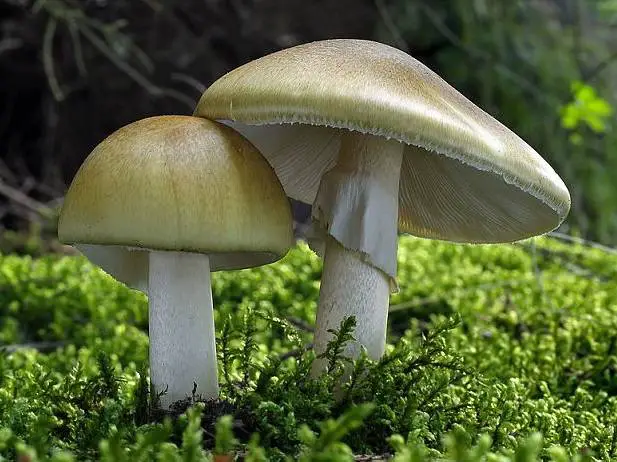
The leg grows up to 5-18 cm, thickness – within 1-2.5 cm. Its location is central, it is cylindrical in shape. The flesh is white, the color does not change when broken. The fungus prefers deciduous trees. It occurs mainly in June-October.
- Dangerous Presence: Green or brownish smooth cap, 4-16 cm in circumference, grows in various environments, including forests and gardens.
- Leg: Central, 5-18 cm, with white flesh, found mainly from June to October.
Here is Most Expensive Mushroom In The World with photos and names.
Amanita muscaria, fly agaric
All types of Amanita muscaria, are not only inedible but also poisonous. For this reason, they must be avoided in the forest.

Panther fly agaric grows in different types of forests from July to October. Likes sandy soil. It has a hat, the diameter of which usually does not exceed 12 cm.
The flesh is white in color, has an unpleasant odor. Does not change its color when broken or cut. The leg is 13 cm long, 0.5-1.5 cm thick. There is a white ring on it, which quickly disappears.
Important! The fungus is deadly to health!
Amanita muscaria grows in different types of forests on mossy litter. The cap is bright red with white dots on the surface. The leg is 20 cm long, 2.5 to 3.5 cm thick. Its base is also covered with white “warts”, which are placed in several rows.
- Toxicity Warning: Inedible and poisonous, with varieties like Panther Fly Agaric and Amanita Muscaria.
- Distinct Features: Bright red cap with white dots, varying leg lengths and thicknesses.
There is another type of this mushroom Amanita Citrina.
It got its name for the reason that outwardly it looks a bit like a toadstool mushroom. It grows in deciduous forests and conifers, the period of activity falls from August-October.
The cap of the mushroom is small – about 10 cm, has a plano-convex shape. At first, it is white, but with time it becomes yellowish-greenish, and noticeable white or grayish flakes form on its surface.
The leg grows up to 10 cm in length, and its thickness reaches 1.5-2 cm. It has a ring that is white at first and then becomes yellowish on the outside. This type of fly agaric belongs to inedible mushrooms. But there is no exact information about its toxicity yet.
- Appearance: Similar to toadstool mushrooms, found in deciduous and coniferous forests from August to October.
- Characteristics: Small, plano-convex cap, yellowish-greenish over time, inedible with uncertain toxicity.
Sulfur yellow honey agaric
This mushroom is poisonous. Prefers to settle on stumps, the ground around them, or rotten wood of conifers and hardwoods. Usually grows in large groups.
The cap grows up to 2-7 cm in diameter. At first, it has a bell-shaped form, then it becomes prostrate. Its color can be different: yellow-brown or sulfur-yellow. The shade is lighter at the edges, more saturated in the center.
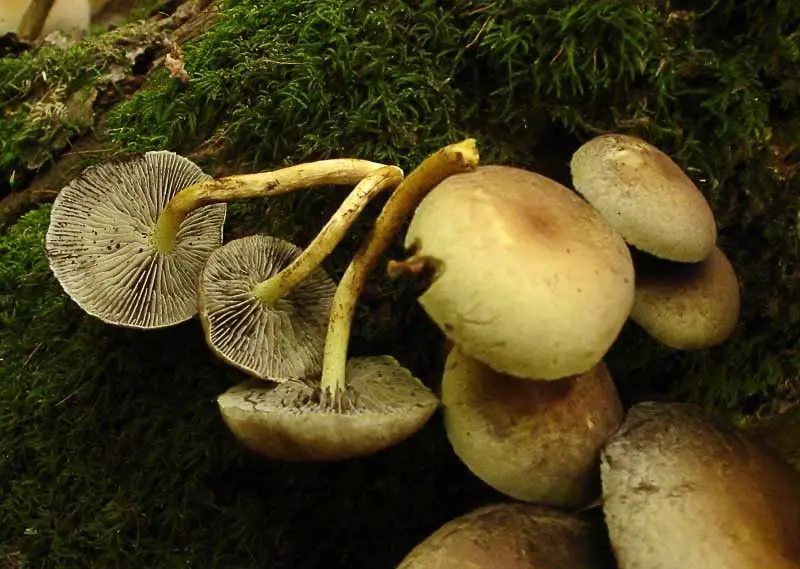
The pulp has a very unpleasant odor and an extremely bitter taste. Has white in color. The leg grows up to 10 cm in length and 0.3-0.5 cm in thickness. The fruit grows everywhere. You can meet him from the end of May until the onset of the first frost.
- Poisonous Presence: Grows on stumps and rotten wood, in groups, with sulfur-yellow caps.
- Characteristics: Bell-shaped to prostrate cap, bitter taste, and unpleasant odor.
Conclusion
Mushrooms that grow in pine forests are distinguished not only by their excellent taste and aroma but also by a number of medicinal properties. They appear in conifers en masse, so avid mushroom pickers have an excellent opportunity to reap a rich harvest.
